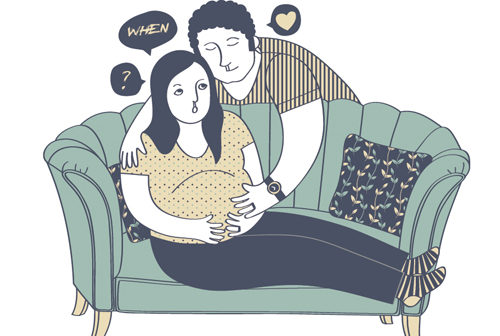Pregnancy can be a complicated business. Given the changes that women’s bodies must undergo and the new pressures placed on their internal systems, it is unsurprising that problems can occur. Luckily, most pregnancy diseases are so rare that the stress of worrying about them often outweighs the actual risk. Getting the recommended check-ups and trusting your intuition is normally the best approach for moms-to-be. Most need not be told twice to err on the side of caution when it comes to the health of their unborn child.
There are, however, complaints experienced by almost all expectant mothers that, while not usually problematic, can be symptomatic of more acute complications. In these cases, the most important question may not be “Do I have these symptoms?” but rather “How do I know if these symptoms point to something more serious?”
Morning Sickness
Morning sickness is one of the common ailments that expectant mothers face, with approximately three in four experiencing nausea or vomiting at some point during their pregnancy. The cause is believed to be a combination of hormonal changes, low blood sugar, and an increased sensitivity to smells, which can trigger the gag reflex.
To begin with, the term “morning sickness” is something of a misnomer. Experiencing nausea at any time of day should not be cause for concern. As new mom Jing Xu* discovered, the severity of the symptoms can vary wildly from person to person.
“I was just over a month pregnant when the nausea and vomiting started to affect me at random times throughout the day,” she explains. “Between months one to four, I would throw up at least once a day – if not more. During this time, I felt fatigued. I thought it was supposed to improve by the fourth month but it only got worse.”
Eventually, Xu’s symptoms eased. In her case, the best cure was a simple regime of rest, plain foods, and ginger-based products, which many moms-to-be find helpful for nausea. Drinking plenty of fluids is also crucial, as most cases of hospitalization result from dehydration rather than more complex medical problems.
However, many pregnant women worry about how much is too much. There is no set amount of vomiting that indicates a more serious complication, but there are some warning signs to look out for. If you are unable to keep food or water down for more than a day, find blood in your vomit, experience abdominal pains, or see that your urine is significantly darker than usual, seek advice from your doctor. There’s also cause for concern if any symptoms persist beyond week 20 of your pregnancy.
In these cases, your doctor may simply prescribe anti-sickness medication. But in up to 2 percent of pregnancies, morning sickness develops into hyperemesis gravidarum (HG), a more severe condition that causes weight loss and vitamin deficiencies that can be detrimental to the unborn child. Women with HG may also suffer from changes in the way their bodies convert fat into energy (a condition known as ketosis) and in some cases will require a hospital stay.
There are also symptoms of other serious conditions to be aware of, says Dr. Weijuan Wang, an obstetrician and gynecologist at Amcare Women’s and Children’s Hospital. “If body temperature stays above 38°C, [the person’s]pulse is greater than 120 beats per minute, or jaundice or [protein in the urine]persists, these can be signs of Wernicke-Korsakoff syndrome,” she warns. The latter is a vitamin B1 deficiency that can affect vision and memory.
Pregnant women should also stay alert to pain or swelling in the legs, which may also be signs of deep vein thrombosis (DVT), or blood clots, that result from dehydration caused by morning sickness.
Braxton Hicks Contractions
The body’s preparation for childbirth is believed to be the reason behind another commonly-experienced side effect of pregnancy: Braxton Hicks contractions. From six weeks onwards, the uterine muscles contract sporadically; however, the movements are not usually felt by the mother until the second trimester (13-28 weeks) – and sometimes not at all.
The sensation is comparable to the early stages of childbirth, but contractions are usually painless and nothing to worry about. Changing one’s body position, staying hydrated, regulating breathing, and taking
a warm bath are some methods that can be used to decrease the frequency and discomfort caused by these contractions.
But as with morning sickness, seemingly normal episodes may in fact be something more serious. This was the case for mom-of-two Wang Li* when she was pregnant with her second child.
“I began to experience the contractions at 15 or 16 weeks, and by 20 weeks they were stronger and more frequent,” she recalls. “By week 23, I was having them two times a day until I had ten in a single day, each five minutes long.”
In cases like Li’s, what appears at first to be normal Braxton Hicks contractions may in fact indicate preterm labor – in other words, the premature opening of the cervix before 37 weeks. At the hospital, Li was injected with anti-convulsants to keep the contractions under control. However, the thinning of the uterine lining that resulted from the contractions made for a difficult birth later on.
Her son is now showing some cognitive and physical signs of developmental delay, though doctors are unable to confirm whether her pregnancy difficulties are responsible for this. But Li was fortunate to be able to continue her pregnancy. If early contractions come too severely or early or if medical attention is sought too late, the prognosis is not always so positive.
There are some key warning signs women should look out for and moms-to-be with signs of preterm labor have the best chance of a healthy birth if they are promptly seen by a doctor who can control the contractions, according to Dr. Lianfang Wu, a gynecologist at New Century Women’s and Children’s Hospital.
“With preterm labor the cervix will be tight and you may have vaginal bleeding and abdominal pain because of the contractions,” she says. “In these cases, we can give sufficient progesterone and the symptoms may disappear with rest at home, as it relaxes the uterine muscles.”
So the best advice for women with seemingly normal Braxton Hicks contractions is to stay mindful of their length, intensity and frequency. If you are having more than five to six an hour or they feel as if they are becoming increasingly longer or more intense then you should consult a doctor as soon as possible.
Similarly, if the contractions cause pain or are accompanied by bleeding or a feeling of pressure on the pelvis, then seeking urgent medical attention could make all the difference for your health and that of your unborn child.
* The names of the women featured in this article have been changed to protect their privacy.
Resources
Amcare Women’s and Children’s Hospital 北京美中宜和妇儿医院
Amcare provides obstetrics, gynecology, pediatrics, family planning,
and psychological consulting services. Dr. Wang speaks Chinese, with English-speaking staff and other foreign language support services available upon request. The Yayuncun branch has 50 wards, private gynecological clinic and a neonatal intensive care unit.
1) Yayuncun branch: Open 24hrs. Bldg 5, Anhui Beili Yiyuan, Chaoyang District (400 100 0016) www.amcare.com.cn 朝阳区朝阳区安慧北里逸园5号楼; 2) Lido branch: Daily 8am-4.30pm.
9 Fangyuan Xilu, Chaoyang District (800 610 6200) 朝阳区芳园西路9号
New Century Women’s and Children’s Hospital (NCWCH) 北京新世纪妇儿医院
New Century Women’s and Children’s Hospital provides gynecology, obstetrics, pediatric, neonatal intensive care and urgent care services for women and children. Dr. Wu speaks Chinese and consultations at the hospital are available in English, Chinese, and Japanese.
Open 24hrs. 51 Wangjing Beilu (Wanghu Park south gate), Chaoyang District (5178 3366) www.ncich.com.cn 朝阳区朝阳区望京北路51号院(望湖公园东门南)
Baby Center (www.babycenter.com)
This website contains advice on a variety of pregnancy and childbirth issues.
Beijing Health Portal (www.puhuaclinic.com/bbs)
A new online ask-a-doctor service from Puhua International Hospital in Shuangjing.
We will be looking at a variety of other pregnancy complications for moms-to-be throughout October on our blog at www.beijing-kids.com/blog.
illustration by Sun Zheng
This article originally appeared on p24-25 of the beijingkids October 2013 issue.
Check out the PDF version online at Issuu.com




